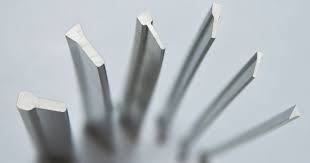For sieving and filtration, a wedge wire screen is a metal mesh element frequently used in screening, filtration, dehydration, and desliming activities. It has high strength, rigidity, and load-bearing capability and can be formed into a variety of rigid screening filter shapes.
Surface profiles and support profiles make up the wedge wire screen. Support profiles are wrapped and welded with surface profiles, which are commonly v-shaped wires. The gap between the surface profiles, which forms the slot through which the filtrate flows, must be precisely controlled. The flow direction is determined by the position of V-shaped wires (surface profiles) with respect to the support profiles. There are wedge wire screens that flow out-to-in or in-to-out.
Advantages:
-
- Its regular filter slots and excellent precision ensure that filter media is retained effectively.
- When compared to other screens, a wedge wire screen has a wider circulation area.
- The small gaps between wedge wires provide a smooth wedge-shaped cross-section, ensuring no dead ends, good block resistance, and ease of backwashing (blow wash).
- It is mechanically strong and can sustain a large pressure drop.
- It is constructed of superior stainless steel wires (SUS304 and 316L) that have excellent corrosion resistance and high-temperature resistance and can withstand a wide range of hostile environments.
- With strong strength, large flow, and high-pressure resistance, it adapts to many forms of fluid direction.
- It has a consistent filtration accuracy and can be used over and over again.
ALL-WELDED WEDGE WIRE SCREENS FOR STRENGTH:
- In a wedge wire screen, each rod and wire intersection is welded. This method’s strength provides several important advantages.
- Reduced costs due to the long life of wedge wire screens.
- Increased tolerance to the differential pressure and temperature cycling stressors.
THE SLOT SIZE OF THE WEDGE WIRE IS PRECISE:
To fulfill system needs, precise slot sizes are available. Screens can reliably retain catalysts, resins, and filter sands of all sizes with slot openings ranging from 0.025mm, 12.5mm, and 0.025mm increments.
LOW HEAD LOSS IN WEDGE WIRE:
Low head losses through the screen surface are aided by the wedge wire screen’s large open area.
NON-CLOGGING WEDGE WIRE:
Wedge wire screens are made by winding a continuous V-shaped wire helically around parallel support rods. To reduce clogging, the uninterrupted slot created by this process permits only two-point contact of particles in the screen slot. This implies:
- The maximum effective flow area is maintained, as is operating efficiency.
- The amount of time spent cleaning clogged screens is reduced.
ECONOMICAL WEDGE WIRE:
The basic design saves money by resulting in a screen with a low initial cost, low maintenance requirements, and easy installation.
LOWER INSTALLATION FEES:
- Costly support media can be discontinued.
- Components are simple to put together.
OPERATING COSTS ARE REDUCED:
- Low head loss and lower running costs derive from the non-clogging slot design.
- Because of the non-clogging slot design, there is less downtime due to plugged displays.
- Screen failure and media loss are less likely with high strength and durability.
LOWER MAINTENANCE FEES:
Abrasion of media particles is reduced due to the smooth surface and sturdy structure, extending the useful life of expensive media and allowing for longer cleaning cycles.
Wedge wire screens are substantially more durable than perforated metal and wire mesh screens.

